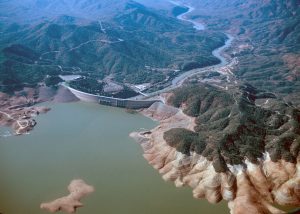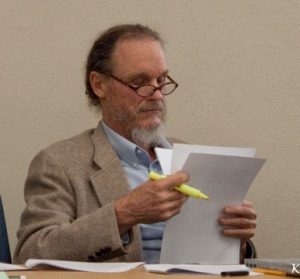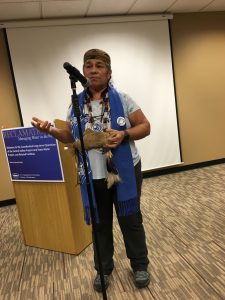A decades-old plan to raise Shasta Dam – resuscitated by the Trump administration — would not only flood what little remain of the Winnemem Wintu’s sacred tribal lands but more broadly denude “thousands of acres” of forested watershed above Lake Shasta.

Hillside erosion around Lake Shasta in a drought year
The estimate of forest area to be inundated is from AquAlliance, a Chico-based environmental group. AquAlliance contends that a higher dam would drown riparian plant and animal life around Lake Shasta, leaving more hillsides naked and more sediment eroding to the bottom of the reservoir.
Media attention to date has largely focused on what raising 602-foot Shasta Dam by 18 1/2 feet would do to the scenic McCloud River, a trout-fishing oasis revered by the Winnemem and protected against dam building by California law.
“The Winnemem hold that land sacred. I hold it sacred. I think most people hold that land sacred,” said Jim Brobeck, a water policy analyst for AquAlliance, which fights what it perceives as threats “to the hydrologic health of the northern Sacramento River watershed,” according to its website.

Jim Brobeck
Officials of the Westlands Water District, headquartered in Fresno and a big backer of raising the dam, have noted that the Winnemem’s sacred sites would be inundated only in peak water years when Lake Shasta, already California’s largest reservoir, filled to an even bigger capacity.
Westlands’ public relations office did not respond to multiple requests – by phone and email – over several weeks from ChicoSol seeking comment on the specifics of this article. However, Westlands’ top executive, Tom Birmingham, recently said in a Sacramento Bee video that inundations “wouldn’t be annually. And when it is inundated it wouldn’t be inundated for long periods of time.”
Brobeck argues that it would take just one big water year to kill the ceanothus (California lilac), manzanita, oak and pine that predominate above the lake’s current high water mark, including up the Pit River and Upper Sacramento River arms of the reservoir.
“What’s the land going to look like all those other years?” countered Brobeck. “Inundate it once and it’s going to kill the vegetation.”
“The U.S. Bureau of Reclamation plans to award a construction contract at the end of 2019.”
Asked about AquAlliance’s estimate of thousands of acres to be inundated by a raised dam, Bureau of Reclamation spokeswoman Erin Curtis said the agency is “currently working on preconstruction and environmental activities and should have a more refined estimate [of the land area] this time next year.”
Curtis, public affairs officer for Reclamation’s Mid-Pacific Region, said a 2014 environmental impact statement (EIS) “lists 340 acres cleared completely and 500 acres with (canopy) removal.” The EIS says facilities that would need to be relocated include “roads, bridges, marinas, homes, railroads, recreation facilities and utilities,” she said.
While the Westlands Water District has, in published reports, heralded the benefits and minimized the harms of raising the dam, Caleen Sisk of Redding, chief of the Winnemem Wintu tribe, said the full environmental effects are not widely realized.

Caleen Sisk
Sisk said that increasing Lake Shasta’s peak level for its 371 miles of shoreline would result in “the inundations of trees, fish pools, animal and bird habitats [and the] flooding of the snow plants, fishers, river otters’ homes and our sacred sites of the Winnemem Wintu.”
Re-establishing existing recreational areas on the reservoir would slash even higher into the forested watershed. The U.S. Forest Service would need to cut another 300 feet of timber beyond the lake’s new high-water mark to re-build inundated camp sites, boat docks and marinas, Sisk told ChicoSol. Those facilities would require road-building and rip-rap repair to try to stave off erosion, she added.
In 2007, the Westlands Water District purchased for nearly $35 million some 3,000 acres along the McCloud River, including the private Bollibokka fishing club, to prevent any development that might make raising the dam more difficult.
Sisk contends that “all trees” along the McCloud up to “the rock house of the Bollibokka” would fall to chain saws if the dam’s height is raised as proposed.

McCloud River
“The trees planted by my great grandfather [in the 1920s] at the McCloud Bridge campground will be cut, along with old-growth oak groves, plus [there will be] vegetation clear-cutting up the river,” Sisk said.
Located about 15 miles north of Redding, Shasta Dam’s construction started in the 1930s and was completed in 1945. It has the capacity to hold more than 4.5 million acre-feet of water. Raising the dam 18 1/2 feet, estimated to cost $1.4 billion, would increase storage by 634,000 acre-feet in peak water years, less in other years. Congress in March approved $20 million for design and preliminary work. The U.S. Bureau of Reclamation, which operates Shasta Dam, plans to award a construction contract at the end of 2019.
Brobeck sees the Chinook salmon’s dams-caused near-extinction as devastating to an ecosystem that stretches from the rivers, creeks and streams of mountainous Northern California to the Pacific Ocean.
Before the dams, salmon died after spawning in the McCloud River and countless other north state waterways. The dead fish were eaten by animals, and their nutrients spread through the forest, making for a healthier watershed, Brobeck said.
Same deal, he believes, at the other end of the salmon’s life journey in the struggling San Francisco Bay Delta, where the fishery has been decimated.
“Now we have pretty much destroyed that largesse that not only fed humans but kept the whole ecosystem healthy,” Brobeck said of the salmon’s decline.
Brobeck objects to sending water south to irrigate “Dust Bowl”-like lands in the western San Joaquin Valley so that wealthy farmers are able to “grow almonds to ship to Saudi Arabia.”
“Water that flows into the Bay is not wasted,” he argued.
Brobeck said all reservoirs lose storage capacity due to sedimentation, and the erosion caused by raising Shasta Dam’s height would send more sediment floating to the bottom of the reservoir.
Chief Sisk said copper, iron and gold mines operated along the Sacramento River watershed before the dam was built.
“Sedimentation is already a problem quietly pushed to the back,” Sisk said. “Those mines have released toxic sedimentation all these years. That is why the fish in Lake Shasta today are mercury poisoned.”
Proponents of raising the dam contend that doing so would actually help the threatened salmon populations by creating colder water in what would become a deeper reservoir. The Bureau of Reclamation is able to release the colder water to aid salmon during their spawning and rearing in the Sacramento River below the dam.
Various state agencies oppose a higher dam, and Brobeck contends the Bureau of Reclamation has mismanaged the dam’s water releases to the devastation of the salmon.
Curtis, the Reclamation spokeswoman, said that “2014 and 2015 … was at the tail end of a five-year drought with … some of the worst conditions that the state had experienced over the last 160 years of recordkeeping.”
She said the bureau had “to make tough choices” those years to meet its legal and contractual obligations.
But Brobeck says of Reclamation that “if you give them more water, there’s no guarantee they’ll manage it with any more integrity than in the past. Look what they did when Obama was in there. What’s going to happen with these devils in there?”
To Brobeck’s way of thinking, David Bernhardt, who went from Westlands Water District lobbyist last year to second-in-command in President Donald Trump’s Department of Interior, is certainly no angel. Reclamation reports to Interior, and Brobeck sees Bernhardt as key in reviving and moving the dam proposal forward.
ChicoSol News Director Dave Waddell researched and wrote this story with support from the UCLA Laboratory for Environmental Narrative Strategies’ Ethnic Media Fellowship Program.
